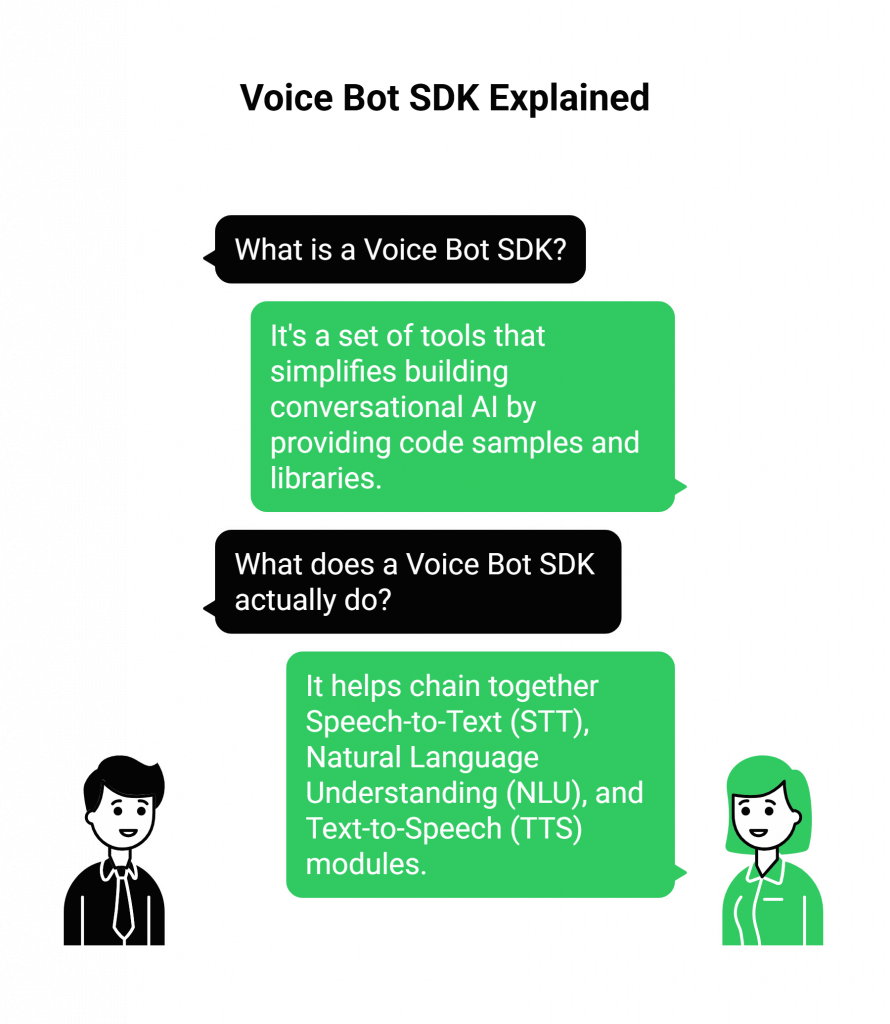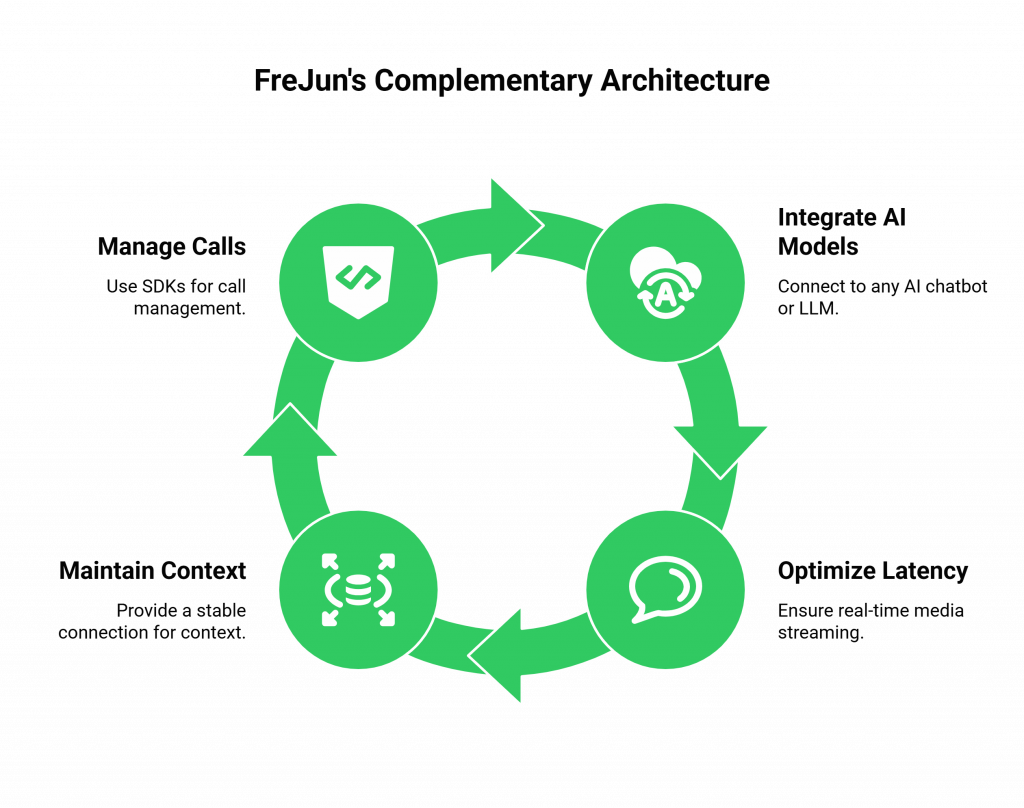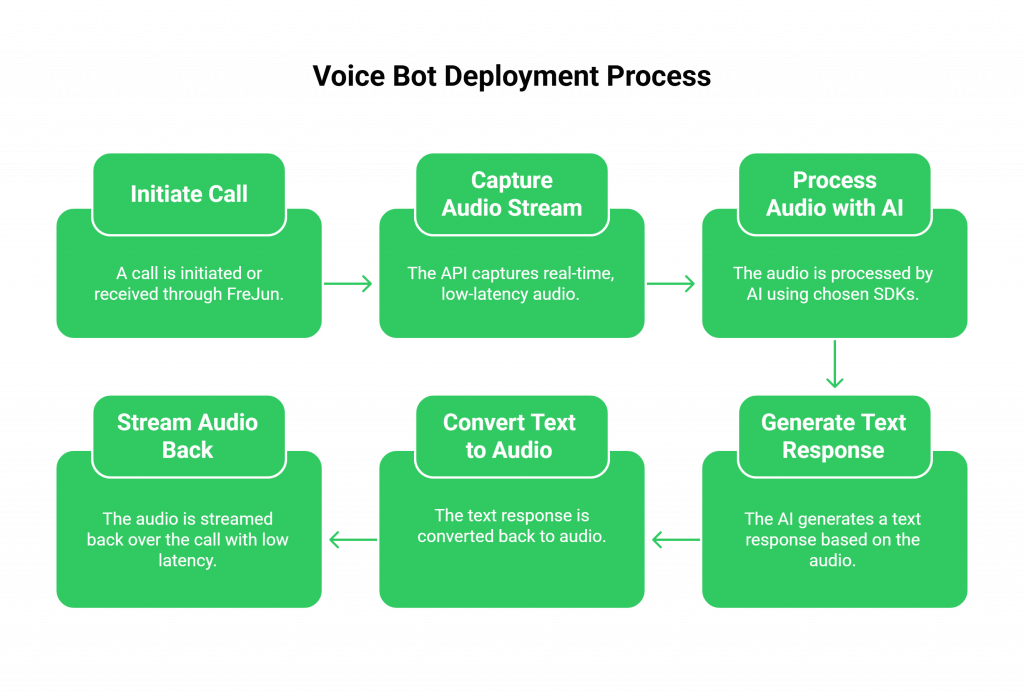Building a smart voice bot is easier with SDKs from OpenAI, Microsoft, and others, but making it speak clearly on real phone calls is still a big challenge. That’s where FreJun AI helps. While your SDK powers the AI brain, FreJun connects it to the real world with low-latency voice infrastructure. In this article, we will show how FreJun works with your AI SDK to handle live phone calls, stream audio in real time, and scale easily.
Table of contents
- The Real Challenge of Building Production-Ready Voice Bots
- What is a Voice Bot SDK and What Does It Actually Do?
- The Missing Piece: Why Your Voice Bot SDK Isn’t Enough
- FreJun: The Voice Transport Layer for Your AI
- How FreJun Complements Your Voice Bot SDK Strategy?
- Building a Voice Bot: The Modern, Scalable Approach
- FreJun vs. Self-Managed Telephony Infrastructure: A Comparison
- Best Practices for Deploying Your AI Voice Bot with FreJun
- Final Thoughts: Focus on AI, Not Complex Voice Infrastructure
- Frequently Asked Questions (FAQ)
The Real Challenge of Building Production-Ready Voice Bots
The capability of AI is advancing at an unprecedented rate. Developers and businesses are eager to move beyond text-based chatbots and create sophisticated, human-like voice agents. The goal is to build AI that can handle customer service inquiries, qualify sales leads, or automate appointment reminders with natural, fluid conversation.
The toolkits for building the “brain” of these bots are more accessible than ever. SDKs from major players like OpenAI and Microsoft provide the framework to connect language models and speech services. However, a critical and often underestimated challenge emerges the moment you try to move your prototype from a developer’s machine to a real-world, production environment.
The problem isn’t just coding the AI’s logic; it’s connecting that AI to the global telephone network reliably and with the imperceptible latency that a natural conversation demands. This is where most voice AI projects stall. They become bogged down by the immense complexity of voice infrastructure, real-time media streaming, and PSTN (Public Switched Telephone Network) connectivity,distractions that pull focus from the primary goal: building a better AI.
What is a Voice Bot SDK and What Does It Actually Do?
Before we address the infrastructure problem, it’s important to clarify the role of a Software Development Kit (SDK) in this context. A Voice Bot SDK is a set of tools, libraries, and code samples that simplifies the process of assembling the core components of a conversational AI.

At its heart, a voice bot is an application that listens, understands, and speaks. This involves three key modules:
- Speech-to-Text (STT): Transcribes the user’s spoken words into text.
- Natural Language Understanding (NLU): This is the “brain,” typically a Large Language Model (LLM), that processes the text to understand intent and formulate a response.
- Text-to-Speech (TTS): Converts the AI’s text response back into audible speech.
An SDK provides the programmatic glue to chain these services together. For instance, the OpenAI Agents SDK or Microsoft Bot Framework offer frameworks to manage the flow of data between these modules, handle real-time events, and structure the conversation logic. They are essential for building the intelligence of your bot, but their domain of responsibility ends there. They are not designed to manage the underlying telephony.
Also Read: WhatsApp Chat Handling Strategies for Medium‑Sized Enterprises in Israel
The Missing Piece: Why Your Voice Bot SDK Isn’t Enough
You’ve used a powerful Voice Bot SDK to create a brilliant AI. It can understand context, answer complex questions, and generate human-like responses. Now, how do you make it answer a phone call from a customer?
This is the missing piece. An SDK helps you build the engine, but FreJun provides the chassis and the transmission to make it move. The challenges of voice transport are fundamentally different from AI development and include:
- Real-Time Media Streaming: Capturing raw audio from a phone call and delivering it to your STT service with minimal delay requires a specialized, low-latency infrastructure.
- Managing Jitter and Packet Loss: Public internet and telephone networks are unpredictable. Handling these issues to ensure clear audio is a constant battle.
- PSTN Interconnectivity: Securely and reliably connecting your internet-based AI application to the global telephone network involves complex protocols (like SIP), carrier negotiations, and regulatory compliance.
- Scalability: Handling one or two concurrent calls on a server is one thing. Scaling to hundreds or thousands requires a geographically distributed, highly available infrastructure engineered for voice.
- Maintaining Conversational Flow: The total time between a user finishing their sentence, your AI processing it, and the voice response beginning is paramount. Any noticeable delay breaks the conversational illusion and leads to a poor user experience.
Attempting to build and manage this complex voice plumbing yourself is a slow, expensive, and resource-intensive distraction. It forces your AI experts to become telecom engineers, pulling them away from what they do best.
FreJun: The Voice Transport Layer for Your AI
This is precisely the problem FreJun was built to solve. We are not another AI model provider or a restrictive, all-in-one bot platform. FreJun is a specialized voice infrastructure platform designed for developers.
We handle the complex voice infrastructure so you can focus on building your AI.
FreJun serves as the robust, reliable, and low-latency transport layer that connects the AI you built with your chosen Voice Bot SDK to any inbound or outbound phone call. Our architecture is engineered from the ground up for speed and clarity, turning your text-based AI into a powerful voice agent that can operate at an enterprise scale.
You bring your own AI,any STT, any LLM, any TTS. We provide the “plumbing” to make it talk.
How FreJun Complements Your Voice Bot SDK Strategy?

Using FreJun doesn’t replace your chosen Voice Bot SDK; it empowers it. Our platform works in concert with your development stack, offloading the most difficult part of the process so you can innovate faster and more effectively. Here’s how FreJun’s architecture complements your AI development workflow:
- Direct LLM & AI Integration: Our platform is model-agnostic. This gives you the freedom to connect to any AI chatbot or LLM you choose, from OpenAI’s GPT-4o to custom-trained models. You maintain 100% control over the AI logic while we manage the voice layer.
- Engineered for Low-Latency Conversations: Real-time media streaming is at our core. FreJun’s entire stack is optimized to minimize the round-trip latency between user speech, your AI processing, and the voice response. This eliminates the awkward pauses that make bot conversations feel robotic and unnatural.
- Enable Full Conversational Context: FreJun acts as a stable transport layer for your voice AI. We maintain a persistent, high-quality connection for the duration of the call, providing a reliable channel for your backend application to track and manage conversational context independently.
- Developer-First SDKs for Call Management: While you use a third-party Voice Bot SDK for AI logic, you can use FreJun’s comprehensive client-side and server-side SDKs to manage the calls themselves. This allows you to easily embed voice capabilities into your web or mobile applications and manage all call logic on your backend, dramatically accelerating deployment.
Also Read: Softphone Implementation Strategy for Remote Teams in Belgium
Building a Voice Bot: The Modern, Scalable Approach
With FreJun, the process of deploying a production-grade voice agent is streamlined and efficient. The development flow is logical and allows your team to focus on their area of expertise.

Step 1: Stream Voice Input from the Call
When a call is initiated or received through FreJun, our API captures the real-time, low-latency audio stream. This stream is instantly available for your application, ensuring every word is captured clearly and without delay.
Step 2: Process with Your AI (Built with Your SDK)
This raw audio is piped directly to your chosen STT service (like AssemblyAI). The resulting text is then passed to your backend application, where the AI logic you built with a platform like OpenAI Agents SDK or Microsoft Bot Framework takes over. Your application maintains full control over the dialogue state and generates a text response.
Step 3: Generate and Stream the Voice Response Back
The text response from your LLM is sent to your chosen TTS service (like ElevenLabs). You simply pipe the resulting audio output back to the FreJun API. We handle streaming it back over the call with ultra-low latency, completing the conversational loop seamlessly.
This three-step process turns the monumental task of voice integration into a simple, API-driven workflow.
FreJun vs. Self-Managed Telephony Infrastructure: A Comparison
Choosing the right foundation for your voice bot can be the difference between a successful launch in days and a failed project that takes months. Here is how building on FreJun’s platform compares to the DIY approach.
| Feature | DIY Telephony Integration | FreJun’s Voice Infrastructure Platform |
| Setup Time | Weeks or Months (PSTN contracts, server setup, SIP trunk configuration) | Minutes (Instant API access and number provisioning) |
| Latency Management | Complex, manual optimization of the entire network stack | Engineered and pre-optimized for low-latency conversations |
| Scalability | Requires significant upfront infrastructure investment and engineering | Geographically distributed, scales on demand automatically |
| Core Focus | Managing voice infrastructure, SIP trunks, codecs, and network issues | Building and refining your AI’s conversational logic and performance |
| Integration | Custom, brittle connections required for each STT/TTS/LLM service | Simple, model-agnostic API to connect any AI stack seamlessly |
| Reliability & Uptime | Dependent on single-server or limited, self-managed infrastructure | High-availability architecture with guaranteed uptime |
| Developer Tools | Limited to low-level audio libraries (e.g., PortAudio) | Comprehensive SDKs for call control and real-time media streaming |
| Expert Support | No specialized support; reliant on internal knowledge or expensive consultants | Dedicated integration support from voice and infrastructure experts |
Best Practices for Deploying Your AI Voice Bot with FreJun
Building on a solid foundation like FreJun allows you to focus on the best practices that truly differentiate your voice bot.
- Map Dialog Flows Rigorously: Before writing a line of code, map out your conversation flows. Plan for common user queries, but also for fallbacks, error handling, and a seamless hand-off to a live agent when necessary.
- Optimize Your AI Processing Speed: While FreJun handles transport latency, your application’s processing speed is still crucial. Use asynchronous models and efficient code to ensure your STT, LLM, and TTS pipeline runs as fast as possible.
- Test with Diverse User Groups: The real world is messy. Continuously test your bot with real users to account for different accents, background noises, and unexpected conversational turns. FreJun’s platform ensures you are capturing clear audio to make this testing effective.
- Prioritize Security and Compliance: Voice conversations can contain sensitive data. FreJun’s platform is built with robust security protocols at every layer, ensuring the integrity and confidentiality of your data and helping you meet compliance standards.
Final Thoughts: Focus on AI, Not Complex Voice Infrastructure
The future of customer interaction is in voice, and the ability to create intelligent, responsive voice agents is a massive competitive advantage. The tools to build the AI itself are readily available, but the true barrier to entry has always been the complex, unforgiving world of telecommunications infrastructure.
You shouldn’t have to be a telecom expert to build a world-class AI voice agent.
By abstracting away the voice layer, FreJun empowers you to do what you do best: innovate. Use your preferred Voice Bot SDK and AI models to create the most intelligent, helpful, and engaging conversationalist possible. Let us handle the enormously complex task of ensuring its voice is delivered with crystal clarity and real-time responsiveness to any user, anywhere in the world.
A Voice Bot SDK gives you the tools to build the intelligence. FreJun gives you the power to bring that intelligence to life.
Start Your Journey with FreJun AI!
Further Reading: How to Build AI Chat with Voice
Frequently Asked Questions (FAQ)
No, FreJun is not a Voice Bot SDK. We are a voice transport layer platform. Our service is designed to complement any AI stack you build using SDKs from providers like OpenAI, Microsoft, or others. We provide the critical infrastructure that connects your bot to the telephone network.
No. Our platform is completely model-agnostic. You can bring your own Speech-to-Text, Large Language Model, and Text-to-Speech services from any providers you choose (e.g., AssemblyAI, OpenAI, ElevenLabs, Google, Azure).
Our entire platform is architected for real-time media streaming. We utilize a geographically distributed infrastructure and have optimized every component, from call ingress to media delivery via our API, to minimize delay and ensure the conversational loop between the user and your AI feels natural and fluid.
While both platforms operate in the communications space, our focus is different. Twilio provides a very broad set of communication APIs as building blocks. FreJun is hyper-focused on providing the most reliable, secure, and low-latency voice transport infrastructure specifically for developers building advanced AI voice agents.
You can do both. While our core strength is PSTN connectivity, FreJun also offers web and mobile SDKs. This allows you to embed the same powerful, low-latency voice capabilities directly into your website or application, providing a consistent experience for your users across all channels.
